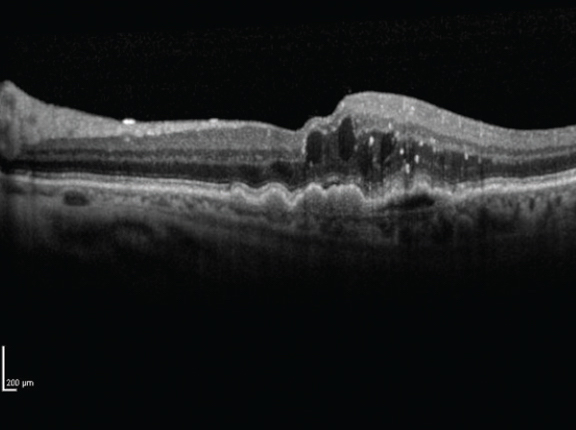 |
| OCT monitoring showed earlier nAMD diagnosis in fellow eyes and could improve patient outcomes. Click image to enlarge. |
Patients who experience neovascular age-related macular degeneration (nAMD) in one eye often go on to develop it in the fellow eye as well, so eyecare providers must be vigilant for signs of active choroidal neovascularization (CNV). In a new study, researchers examined both the features of nAMD observed on OCT and the impact of those features on visual outcomes at diagnosis and after one year of treatment and found the second eyes had better vision smaller pigment epithelial detachment (PED) heights and fewer symptoms.
A total of 52 patients whose eyes were diagnosed sequentially with nAMD were treated with three monthly loading doses of anti-vascular endothelial growth factor (VEGF) agents, followed by further intravitreal injections, as required. The authors assessed characteristics associated with nAMD severity, including the type and extent of reported symptoms, location and degree of retinal fluid, clinical evidence of blood and presence and height of any associated PED detected by OCT.
“Although many retinal characteristics were similar at diagnosis and after one year of treatment, we found that the second eyes to develop nAMD tended to have better vision and smaller PED heights,” the authors explained in the study.
At diagnosis, second eyes had fewer and less specific symptoms compared with first eyes. “This difference underscores the importance of regular monitoring of fellow eyes of patients with unilateral nAMD to permit earlier diagnosis and treatment at less advanced stages of disease,” the authors noted.
OCT was able to detect signs of active CNV, which may be why second eyes tended to be diagnosed while vision was better and PED height was smaller and—in many cases—before the disease became symptomatic.
Just as previous studies have reported, no direct correlation between vision and central macular thickness was found; however, there was a modest correlation between PED height at one year and worse VA by one year, as well as an association with the presence of intra-retinal fluid at one year.
“Similar to our study, PEDs in eyes in the HARBOR study decreased in size with treatment; however, PED height at one year was not linked to visual outcomes, as it was for the eyes in our study. Interestingly, a recent study found that treatment-refractory SRF does not lead to long-term vision loss,” the authors explained. “By contrast, intra-retinal fluid is more closely associated with sustained visual acuity loss, as was the case in our study.
“Understanding the implications of these anatomical features and other disease markers on vision not only benefits clinical practice, but sets the stage for future investigations into whether modifying those factors might improve patient outcomes,” the authors concluded.
Sema Akkan Aydogmus, Onwuka O, Saddemi J, et al. Second eyes to develop neovascular age-related macular degeneration have fewer symptoms and better one-year visual outcomes. BMC Ophthalmol. July 7, 2023. [Epub ahead of print.] |

